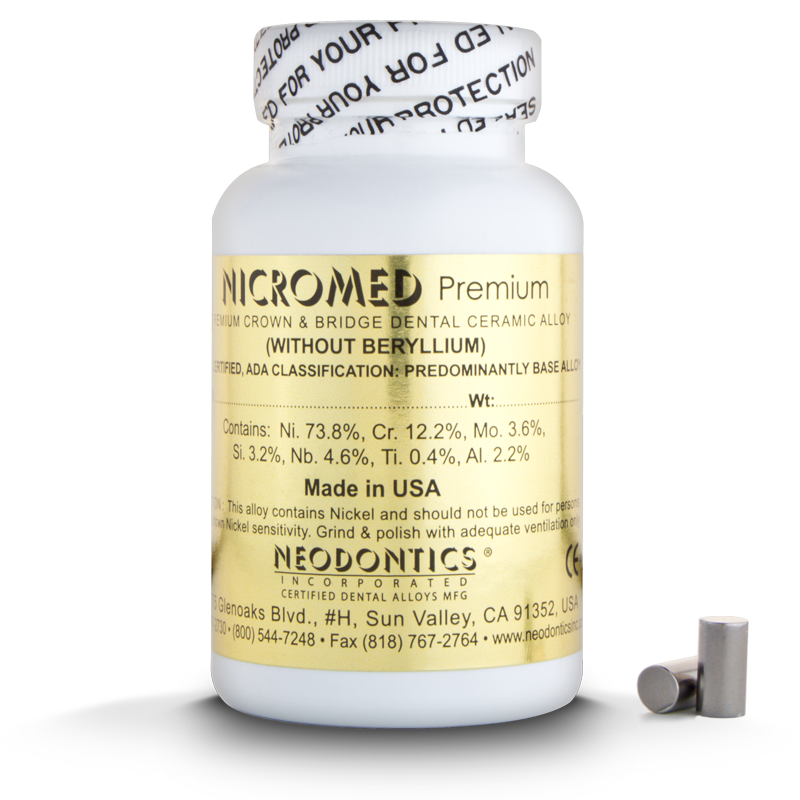
Physical Data
| Melting Range | 1180°c-1268°C (2165°F-2314°F) | Casting Temp | 1427°C (2600°F) |
|---|---|---|---|
| Hardness | 320 HV | CTE | 14.1 *10-6 @25-600°C |
| Yield Strength | 85,000 PSI | Tensile Strength | 140,000 PSI |
| Elongation | 4% | Density | 8,70 g/cm3 |
| Specific Gravity | 8,02 g/cm3 |
Section I
Material Identification
Chrome, Molybdenum Base AlloyMaterial Name
NicromedSection II
Ingredients & Hazards
| Ingredients | Cas # | % Composition by weight |
|---|---|---|
| Nickel (Ni) | (7440-02-0) | Balance |
| Molybdenum (Mo) | (7439-98-7) | 3~4% |
| Chromium (Cr) | (7440-47-3) | 12-13% |
| Aluminum (Al) | (7429-90-5) | 2~2.4% |
| Silicon (Si) | (7429-90-5) | 3~3.5% |
| Titanium (Ti) | (7440-32-6) | 0.3~0.4% |
| Niobium (Nb) | (7440-03-1) | 3.5~4.6% |
Hazard Data
- For pure Molybdenum (Fumes & Dust)
- Eight(8) Hr. TLV-5mg/m³
- Pure Nickel & Chromium (Fumes & Dust)
- Eight(8) Hr. TLV - 1mg/m³
Section III
Physical Data
| Appearance: | No Odor, White (Platinum) Color |
| Each Ingot weight: | Approximately 5 – 8 grams |
| Solubility in water: | Insoluble |
| Fire & Explosion: | Fire and explosion resistant |
| Reactivity Data: | At ordinary and at high temperature, the alloys oxidize, but are stable. At very temperatures alloy may produce fumes. |
Section IV
Health Hazard Information
Individual components and some of their compounds, in dust and fume form are suspected causes of progressive lung damage, and disease. Symptoms include: Weight loss and/ or difficulty breathing, and skin rash and itching.Special Precautions
Avoid inhalation of fumes and dust. Wear protective clothing. Grind and polish with adequate ventilation. This alloy contains Nickel, not to be used in individuals with Nickel sensitivity.Spill or Leak Procedures
Remove dust by vacuuming or wet sweeping to prevent powdering in the air. Wear approved respirators and protective clothing. No special precautions are required for bulk (solid) shapes such as ingots.The information in this MSDS was obtained from sources, which we believe are reliable. However, the information is provided without any representation or warranty, express or implied regarding the accuracy or correctness.
These alloys contain Nickel, Chromium, Molybdenum, Aluminum, Silicon, Titanium, and Niobium. University studies have established that alloys in these categories are not only biocompatible, but clinically safe as well. The alloy in solid form is generally not considered hazardous. Grinding, melting, cutting or any other process that releases dust or fumes can produce hazardous levels and should be avoided.
Section V
First Aid
| Eye Contact: | Flush eyes Thoroughly with running water, even under eyelid. |
| Skin Contact: | Flush skin and scrub thoroughly with soap and water. |
| Inhalation: | Remove person to fresh air. Assist breathing with additional oxygen if necessary. |
WAXING
Procedure is similar to the application of precious and semi-precious alloys. Waxing could be as thin as 0.3mm.SPRUING
Use direct method of spruing for single units, and the indirect method for multiple units.INVESTING
Use high heat phosphate bounded investment. Use ring liner. Use investment manufacturer instructions.BURNOUT
After proper bench set, place the ring in the oven at room temperature (or as high as 600ºF=315ºC), and raise the temperature to 1700ºF (926ºC) with one hour soaking time. Add extra time to hold time for additional rings placed in the oven.
MELTING/CASTING
Use Induction Casting unit or Torch Casting (gas/oxygen). For torch casting use multiple orifice tips. Do not use acetylene torch. Do not use crucible used for another alloy. Keeps the torch moving in rotating motion for even distribution of heat on the ingots. Release the casting arm when the ingots lose definition and puddle. Induction Casting set the temperature to 2700ºF (1480ºC). Set the casting arm speed between 425 and 450 rpm.
PREPARATION OF FRAME WORK
Follow the same procedure as for precious alloys. Sandblast the area bearing porcelain, and clean with ultrasonic.
OPAQUE & PORCELAIN APPLICATION
Apply opaque in thin slurry. Fire the opaque slurry coating in ten degrees higher temperature. Quicker method is using the same procedure without degassing. Use opaque and porcelain manufacturer instructions
